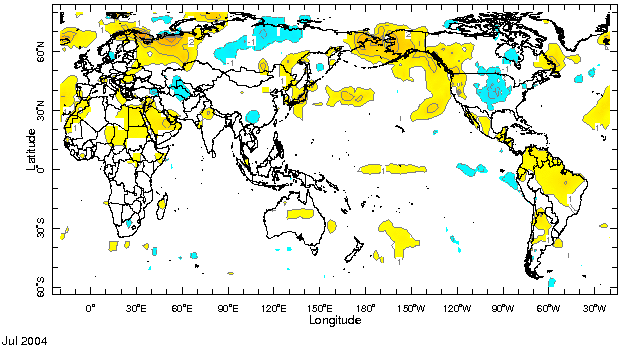|
IRI Climate Digest
August 2004
July Global Climate Summary
Climatological Background
In July, heating of the continents in the Northern Hemisphere results in strengthened monsoon systems which bring rains to West Africa, South Asia, and southwestern North America. In the Southern Hemisphere winter has set in, with stronger north-south temperature gradients fueling active mid-latitude storm tracks.
Monthly Mean Temperature (1961-1990), data from the Climate Research
Unit, University of East Anglia


Monthly Mean Precipitation (1961-1990), data from the Climate Research
Unit, University of East Anglia


Temperatures
Highlights
The temperature anomaly patterns over the Americas have been remarkably persistent since May. In North America positive temperature departures continued to dominate over Alaska and far western Canada during July, while cooler-than-average conditions prevailed over eastern Canada and the northeastern United States. South America was dominated by above-average temperatures, with the exception of reported cold outbreaks in the far southern reaches of Patagonia. Below-average conditions were also experienced at higher elevations in the Peruvian Andes. Northern Europe and Russia east of the Urals experienced relatively warm conditions, while Northern Siberia continued to show colder-than-average temperatures. Reports from Africa indicated generally warmer conditions except for some reports of below-average temperatures in South Africa.
Temperature Difference from the 1961-1990 mean, with data
from NCEP Climate Prediction Center, CAMS.


Precipitation
Highlights
In general, the progress of the summer rainy seasons has been mixed during July. In Africa drier-than-average conditions continue to be felt in Senegal and Guinea while above-average amounts were recorded in parts of southern Mali and Burkina Faso, with mixed anomalies in Niger. Continued dryness was also experienced in eastern Africa with the exception of the horn in eastern Ethiopia and Somalia. Dry conditions also prevailed for northwestern India and Pakistan while heavier-than-average rainfall was evident in eastern India and much of southern China. In North America, heavy rains continued to be experienced through much of the eastern half of the United States except along the Gulf states. Rainfall associated with the North American monsoon was heavier than average over western Mexico. In South America above-average rainfall was observed over Peru and Ecuador as well as in central Argentina, while dry conditions characterized July precipitation over Uruguay and southern Brazil.
Precipitation Difference from 1979-1995 mean, with data
from NCEP Climate Prediction Center, CAMS-OPI.


Oceanic Conditions
Tropical Pacific: July average sea surface temperatures in the central equatorial Pacific increased to more than 1°C above normal in a band from the dateline to about 140°W. The area of below-normal sea surface temperatures in the eastern equatorial Pacific increased in extent from June and harbored regions with temperatures more than 1°C below normal. See the latest IRI ENSO Update for a detailed summary and outlook.
Tropical Atlantic: The region of below-normal temperatures seen in the eastern equatorial Atlantic in June fragmented in July, although cool temperatures along the Guinea Coast persisted throughout the month. Temperatures warmed slightly with respect to normal near 10°N.
Indian Ocean: The cooler-than-normal ocean temperatures seen in June off the coast of Africa from Madagascar to the Arabian Sea warmed in July, while conditions cooled with respect to normal in the central and eastern tropical Indian Ocean.
Extratropical Oceans: Large areas of much warmer-than-normal sea surface temperatures continued to dominate most of the North Pacific. Ocean temperatures in the Canadian Maritimes warmed with respect to climatology between June and July, and the large area of warmer-than-normal temperatures that has persisted for several months in the eastern Atlantic remained in place in July. The warmer-than-average temperatures in the central South Pacific and central South Atlantic weakened slightly from the previous month.
Monthly Sea Surface Temperature Difference from the 1971-2000 mean,
with data from the Environmental Modeling Center, NCEP/NOAA.


Contents |
Special |
Impacts |
Climate |
Forecast
| 
